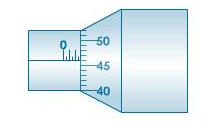Can you explain all types of errors found in the screw gauge and its working?
Types of error in micrometer screw gauge reading
Every micrometer prior to its use should be thoroughly checked for backlash error or zero error.
- Backlash error: Sometimes due to wear and tear of the screw threads, it is observed that reversing the direction of rotation of the thimble, the tip of the screw does not start moving in the opposite direction immediately, but remains stationary for a part of rotation. This is called back lash error.
This error occurs if we move the screw in one direction and then in opposite directions repeatedly.
- Zero error: If on bringing the flat end of the screw in contact with the stud, the zero mark of the circular scale coincides with the zero mark on base line of the main scale, the instrument is said to be free from zero error. Otherwise an error is said to be there. This can be both positive and negative zero error.
Calculating micrometer screw gauge reading:
Total observed reading = main scale reading + (circular scale division coinciding the base line of main scale) x least count
True diameter = observed diameter � zero error
Example, main scale reading = 2mm or 0.2cm
Circular scale reading = 56, so 56 x 0.001 = 0.056cm
So observed reading = 0.2 + 0.056 = 0.256cm
Determination of Diameter of a Wire
The wire whose thickness is to be determined is placed between the anvil and spindle end, the thimble is rotated till the wire is firmly held between the anvil and the spindle. The rachet is provided to avoid excessive pressure on the wire. It prevents the spindle from further movement. The thickness of the wire could be determined from the reading as shown in figure below.

Reading = Linear scale reading + (Coinciding circular scale x Least count)
= 2.5 mm + (46 x 0.01)
= (2.5 + 0.46) mm
= 2.96 mm